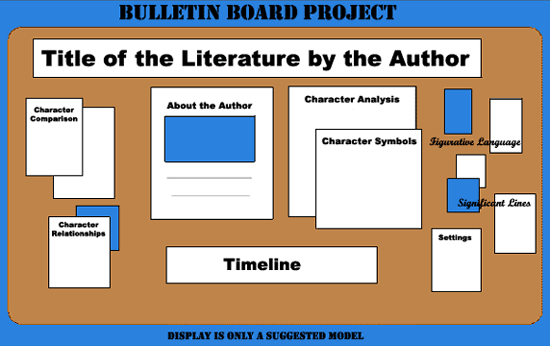
Bulletin Board
BULLETIN BOARD FORMAT. Your
project must satisfy ALL of the following criteria:
- Everything needed for the bulletin board is enclosed in a
large manilla envelope. This includes cut-out letters, illustrations,
typed information, borders, yard, labels, etc.
- The design for how the bulletin board materials will be displayed
is sketched on the outside of the envelope.
- Rule lines (base, mid, and top) have been drawn lightly in
pencil with a ruler. Rule lines have been neatly and carefully
erased after drawing materials have dried thoroughly. No smears.
- Any material that has been cut out is trimmed neatly and
precisely. Straight edges are straight. Irrelevant background
is trimmed out.
- The bulletin board illustrations are decorated colorfully
with paint, colored pencils, felt-tip pens, crayon, pastels,
or another medium specifically approved by the teacher.
- Illustrations may be original artwork, traced or copied artwork,
graphic designs, or appropriate photographs cut from magazines.
- Designer names must appear on a card , as part of the bulletin
board display
- No words are misspelled.
- No punctuation errors are made.
- No capitalization errors are made.
- No usage errors are made. Watch out for pronoun and verb
errors.
A wise student would sketch all lettering or drawings lightly
in pencil and proofread several times. A very wise student would
enlist the aid of several proofreaders.
BULLETIN BOARD TOPICS. The purpose of these posters is to visually
illustrate major concepts from the work studied. In order to
receive a good grade, your bulletin board project must TEACH
something about the work. Looking at your bulletin board should
enlighten the viewer.
- About the Author: Research
the author's life and include a brief overview, concentrating
on the events in the writer's life which seem especially relevant
to the work studied. Include a list of the writrer's major works
and a picture (if available).
- Timeline: Prepare
an illustrated timeline of events in the work. Although the actual
events may not be revealed chronologically (by recollection and
flashback perhaps), remember to proportion the length of the
line to the total number of years the work covers. Include illustrations
or quotes at major points on the line.
- Major Character Analysis: Prepare an analysis of one of the major characters.
Include an illustration of the character as described by the
author and include significant quotes from the work which demonstrate
the various methods of characterization -- name, physical description,
what the character says, what the character does, how other characters
react to your character, etc.
- Character Comparison: Compare
and contrast two of the major characters who can be analyzed
as doubles and/or opposites. Include an illustration of each
character as the author describes them and include significant
quotes from the work which demonstrate the various methods of
characterization -- names, physical descriptions, what the characters
say, what the characters do, how other characters react to your
characters, etc.
--------------------------------------------------------OR-------------------------------------------
Character Relationships: Make a cluster
diagram showing the relationships of the characters to each other.
Include a sketch of each character or perhaps a specific object
associated with each one. Also include a characteristic saying
or a significant quote about each. Start with the main character(s)
at the center.
- Character Symbols: Frequently,
characters in a work are associated with particular objects which
take on a symbolic value. Prepare a chart showing characters
and appropriate objects, explaining how the object represents
the character. If no object is actually associated with the character
in the work, you may choose an object which you think would be
appropriately symbolic for your characters and explain your choices.
- Settings: Illustrate the major
settings, including descriptive quotes from the work and indicating
major events that occurred at each setting. If appropriate, consider
using a map format.
- Figurative Language: Find several
examples of various figures of speech: hyperbole, metaphor, simile,
personification, etc. Prepare a chart listing and illustrating
your examples.
--------------------------------------------------------OR--------------------------------------------
Significant Lines: Select what you
consider to be the most important quote, quotes, or longer passage
in the work. Prepare a collage which truly illustrates the meaning
of the lines from the work. Include the lines themselves.
Particular works may suggest other possible topics to you.
If you have an idea for a poster which is not included above,
discuss it with your teacher.
|
